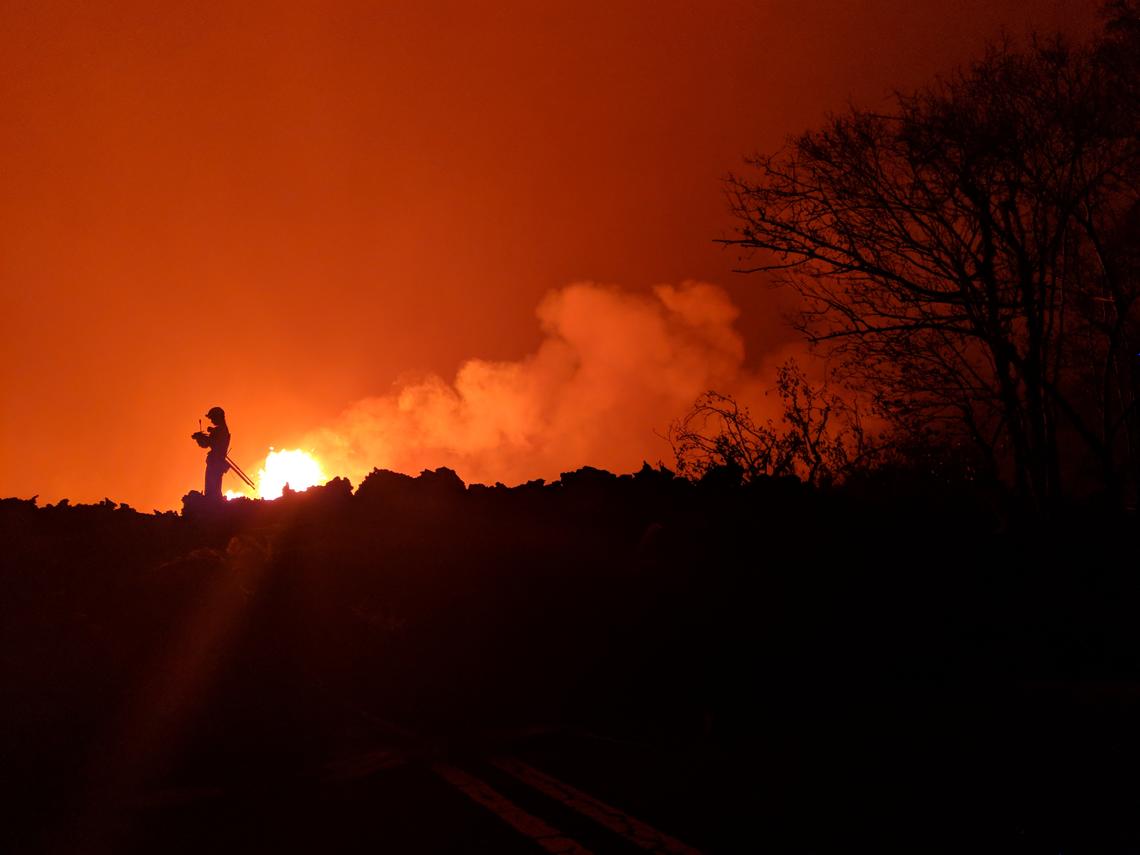Incandescent Blocks Expelled from Volcano, Land Along Crater Rim

USGS scientist in the Lower East Rift Zone documenting the spectacular ~50 m tall fissure 7 lava fountain to the east which had lit up the sky in a red hue. PC: May 27, 2018, Credit: Brett Walker, USGS.
Incandescent Blocks Expelled From Crater:
At the summit of the Kīlauea volcano on Hawaiʻi Island, ash has been continuously erupting from the vent within Halemaʻumaʻu Crater, according to HVO scientists.
At 1:56 a.m., there was an explosion that sent ash to 15,000 feet above sea level.
“The ash cloud rose pretty much vertically and then drifted only a little bit to the NW because winds are very calm,” said Wendy Stovall, Geologist/Volcanologist with the USGS Hawaiian Volcano Observatory. “There were also some incandescent blocks that were thrown out of the vent and landed in Halemaʻumaʻu and just along the edge of the crater rim,” said Stovall.
After the eruption last night, one of the scientists that was on watch noted white (incandescent) blocks that showed up on webcam imagery.
“The reason that they are incandescent is because you’re now changing our frame of reference. These magmatic gasses–as they are streaming through the vent–are very hot, and those are continuing to heat the blocks that are in the walls of the vent. So when the explosions happen, it throws out those hot blocks and we can see them in webcam imagery. Especially overnight–it makes it very easy to see them overnight,” said Stovall.
According to Stovall, the HWO is working to install thermal cameras to better quantify when those incandescent blocks are expelled from the crater, how big they are and how far they are reaching without putting anyone in harms way.
“Over the past 24 hours, we’ve seen that Fissure 8 has been the dominant producer of lava. It is the same one that was active yesterday and overnight that produced the lava flow that went through the eastern edge of Leilani Estates,” said Stovall during a press conference on Tuesday morning.
“Overnight, the lava fountain from Fissure 8 was reaching heights of 200 feet and it was feeding a flow that was traveling to the northeast. It was overprinting the lava flow that had inundated Leilani Estates on the night before,” said Stovall.
According to Stovall, the flow crossed Pohoiki Road at 5 a.m. today and it was moving across the Puna Geothermal Venture access road. “It’s continuing its advancement in a northeasterly direction,” authorities said.
“There’s also been volcanic glass and other material that are being blown downwind from that high fountain at Fissure 8 and there were reports of Pele’s Hair (volcanic glass) falling in Pāhoa. It’s important that people realize that the stuff that might be falling from the sky, especially in Pāhoa is volcanic glass that can cause skin and eye irritation similar to volcanic ash. These are really sharp pieces: It can poke into you’re skin, so just be aware that if you’re sensing that there’s little rocks falling from the sky or little pieces of volcanic material falling from the sky, you should be cautious of those. Don’t rub it onto your skin because it can embed in your skin and irritate you. Rise your skin off with water if you encounter pieces of volcanic glass falling from the sky.”
“The volcanic gas emissions rate from the fissures still remain high,” said Stovall, who noted that tradewinds are forecast to come back in the few days ahead. “So hopefully that will mean that the vog and the falling of volcanic glass from the sky will switch directions and not impact people into Pāhoa and other areas to the north.”
Day 19 of Hawaiʻi Volcanoes National Park Closure:
Two thirds of the Hawaiʻi Volcanoes National Park remains closed, marking the 19th day of the park closure. Jessica Ferracane, the Public Information Officer for Hawaiʻi Volcanoes National Park said the entire park is without water in the Kīlauea sector.
“It is unknown how many damaged water lines there are,” said Ferracane who said there are at least eight. Six of them have been repaired, but authorities say there could be more. “We don’t know when we’re going to be able to turn the water back on at the park,” said Ferracane who said authorities were monitoring the current eruption cycle.
“Since the earthquakes and seizmicity remains elevated and ongoing, there seems to be little sense in fixing these very old pipes that keep getting damages with the new earthquake cycle.” said Ferracane.
As of last night, National Park officials reported significant damage to Hilinapali Road. There is also earthquake damage reportedly sustained at three buildings including the Jagger Museum, the USGS Hawaiian Volcano Observatory as well as the Visitor Emergency Operations Center.
Tradewinds Forecast to Return, Shift Emissions Mostly Downstream
“We do have some lighter winds and they are pushing some of the volcanic emissions toward the north and northwest. We expect that to continue through today, but we do have our tradewinds starting to pickup later on this evening and tonight and tomorrow,” said Ian Morrison, Meteorologist with National Weather Service/NOAA.
Morrison noted that the shift back to trades should send the emissions mostly downstream to the southwest.
“Otherwise its a very rainy day over on the windward side of the Big Island,” said Morrison, who noted that the rain should continue today, tonight and into tomorrow with some clearing expected by tomorrow late in the morning.










